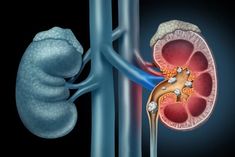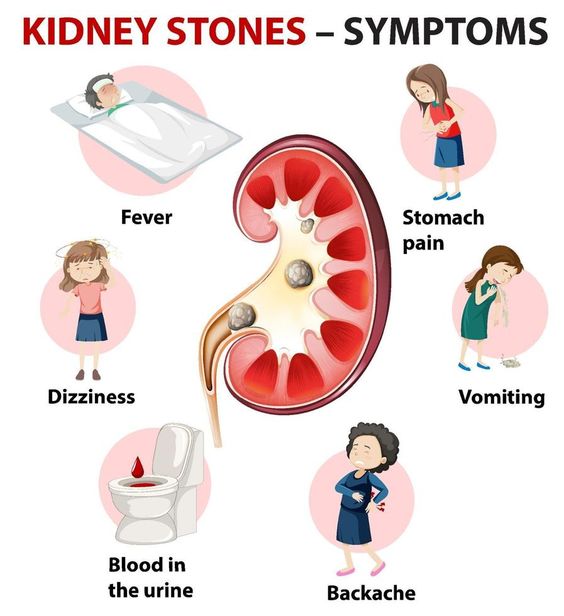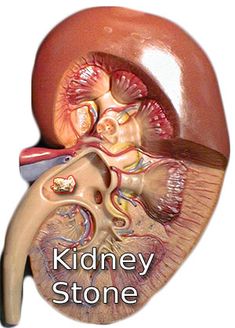Understanding Renal Stone Diseases: Causes, Symptoms, and Treatment:
Renal stone diseases, commonly known as kidney stones, affect millions of people worldwide, causing significant discomfort and sometimes severe complications.
Understanding the causes, symptoms, and treatment options for renal stones is crucial for effective management and prevention.
This comprehensive guide explores the intricacies of renal stone diseases, providing valuable insights into their prevention, diagnosis, and treatment.

Causes of Renal Stone Diseases:
Renal stones are formed when certain substances in the urine, such as calcium, oxalate, and uric acid, become concentrated and crystallize within the kidneys. Several factors contribute to the formation of kidney stones, including:
Dehydration: Inadequate fluid intake can lead to concentrated urine, promoting the crystallization of minerals and the formation of stones.
Dietary Factors: High intake of oxalate-rich foods like spinach, nuts, and chocolate, as well as excessive salt or sugar consumption, can increase the risk of kidney stone formation.
Genetic Predisposition: Individuals with a family history of kidney stones may have a higher susceptibility to developing them due to genetic factors.
Underlying Medical Conditions: Certain medical conditions such as hyperparathyroidism, gout, and urinary tract infections can predispose individuals to kidney stone formation.
Medications: Some medications, including diuretics, antacids containing calcium, and certain chemotherapy drugs, may increase the risk of kidney stone formation.
Symptoms of Kidney Stone Diseases:
The symptoms of renal stone diseases can vary depending on the size and location of the stones within the urinary tract. Common signs and symptoms include:

Severe Pain: The most characteristic symptom of kidney stones is intense pain, often described as sharp and cramping, typically located in the back or side and radiating to the lower abdomen and groin.
Hematuria: Blood in the urine, resulting in pink, red, or brown discoloration, may occur due to irritation or damage to the urinary tract caused by passing kidney stones.
Urinary Urgency and Frequency: Individuals with kidney stones may experience a frequent urge to urinate, accompanied by discomfort or pain during urination.
Nausea and Vomiting: Nausea and vomiting may occur as a result of severe pain or associated with the body’s response to kidney stone-related complications.
Urinary Tract Infections (UTIs):Kidney stones can increase the risk of urinary tract infections, leading to symptoms such as fever, chills, and discomfort during urination.
Renal Stone Diagnosis and Treatment Options:
Diagnosing renal stone diseases typically involves a combination of medical history evaluation, physical examination, imaging studies, and laboratory tests. Common diagnostic modalities include:
Imaging Studies: X-rays, ultrasound, computed tomography (CT) scans, or magnetic resonance imaging (MRI) scans are used to visualize the size, number, and location of kidney stones within the urinary tract.
Urinalysis: Analysis of urine samples can help detect the presence of blood, crystals, or infection, providing valuable diagnostic information.
Blood Tests: Blood tests may be conducted to evaluate kidney function and identify underlying metabolic disorders that contribute to kidney stone formation.
Treatment options for renal stone diseases depend on factors such as the size, composition, and location of the stones, as well as the severity of symptoms. Common treatment approaches include:
Fluid Intake: Increasing fluid intake, particularly water, helps dilute urine and reduce the risk of stone formation. Adequate hydration is essential for preventing recurrent kidney stones.
Medications: Depending on the type of kidney stones and underlying conditions, medications such as pain relievers, alpha-blockers, or medications to reduce stone formation (e.g., thiazide diuretics or allopurinol) may be prescribed.
Extracorporeal Shock Wave Lithotripsy (ESWL): ESWL is a non-invasive procedure that uses shock waves to break large kidney stones into smaller fragments, making them easier to pass through the urinary tract.
Ureteroscopy: In cases where kidney stones are located in the ureter or kidney and cannot be effectively treated with ESWL, ureteroscopy may be performed. This minimally invasive procedure involves inserting a thin, flexible scope through the urethra and bladder to remove or break up the stones.
Surgery: Surgical intervention may be necessary for large or complex kidney stones that cannot be treated with less invasive methods. Procedures such as percutaneous nephrolithotomy (PNL) or open surgery may be performed to remove the stones directly from the kidney.
Renal Stone Prevention Strategies:
Preventing recurrent kidney stones involves adopting lifestyle modifications and dietary changes to reduce the risk of stone formation. Key preventive strategies include:
Hydration: Maintaining adequate fluid intake, particularly water, helps prevent urine from becoming concentrated and reduces the likelihood of kidney stone formation.
Dietary Modifications: Limiting intake of oxalate-rich foods, sodium, and sugar while increasing consumption of fruits, vegetables, and low-fat dairy products can help prevent the formation of certain types of kidney stones.
Calcium Intake: Consuming adequate amounts of dietary calcium, preferably from food sources rather than supplements, can help reduce the risk of calcium oxalate stones.
Moderating Protein and Sodium Intake: Limiting consumption of animal protein and sodium can help prevent the formation of uric acid and calcium-based kidney stones.
Regular Monitoring: Individuals with a history of kidney stones should undergo regular medical check-ups, including urine and blood tests, to monitor kidney function and identify any potential risk factors or underlying conditions that may contribute to stone formation.
FAQs:
What are renal stone diseases, and how do they form?
Renal stone diseases, commonly known as kidney stones, are hard mineral deposits that form in the kidneys or urinary tract. They develop when certain substances in urine, such as calcium, oxalate, and uric acid, become concentrated and crystallize.
What factors contribute to the formation of kidney stones?
Several factors increase the risk of kidney stone formation, including dehydration, dietary habits (high intake of oxalate-rich foods, salt, or sugar), genetic predisposition, underlying medical conditions (hyperparathyroidism, gout), certain medications, and family history.
How are kidney stones diagnosed?
Diagnosis of kidney stones typically involves a combination of medical history evaluation, physical examination, imaging studies (X-rays, ultrasound, CT scans), and laboratory tests (urinalysis, blood tests) to assess kidney function and identify underlying metabolic disorders.
Can kidney stones be prevented?
Yes, kidney stones can often be prevented by adopting lifestyle modifications and dietary changes. Strategies include maintaining adequate hydration, limiting intake of oxalate-rich foods, sodium, and sugar, consuming adequate dietary calcium, moderating protein intake, and undergoing regular medical check-ups.
Conclusion:
Renal stone diseases pose significant challenges to affected individuals, often causing severe pain and discomfort.
However, with proper understanding, timely diagnosis, and appropriate treatment, the impact of kidney stones can be minimized, and recurrence can be prevented.
By adopting preventive measures, making lifestyle modifications, and seeking medical guidance when necessary, individuals can take proactive steps to safeguard their urinary health and reduce the risk of kidney stone formation.
Remember, early detection and intervention are key to managing renal stone diseases effectively and maintaining overall well-being.



